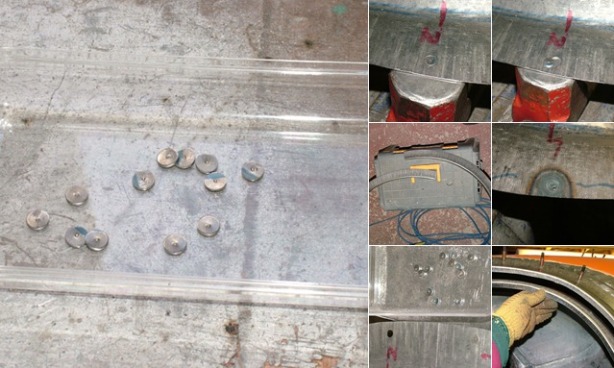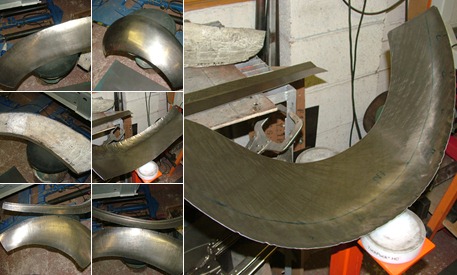The only way to recover the balls up I made of the rear quarter was to roll my sleeves up, grab the slapper and dolly and drive the neighbours nuts (god bless ‘em for their patience) with the dink, dink, dink of a bit of planishing.
 Getting it right involves two techniques which I ought to be bloody good at by now. The first is to use contour gauges to establish where the metal should be and the second involves using an aerosol can of paint and a sanding block to establish when you’ve got it there.
Getting it right involves two techniques which I ought to be bloody good at by now. The first is to use contour gauges to establish where the metal should be and the second involves using an aerosol can of paint and a sanding block to establish when you’ve got it there.
Whilst I was working on the rear quarter I took the opportunity to fill in the hole where the side marker lamp fits on the US spec Spider. I put a light crown in a piece of scrap sheet and placed it behind the hole, scribed round it, then cut it very carefully to the line with my Gilbow hand shears. I would normally lightly tack the piece in place with the MIG before fillerless TIG welding it in place. That leaves a few lumps of filler wire to grind down so I thought I’d try the TIG from the start. Bad plan, I won’t do that again.
As I welded it in I dressed the HAZ with a hammer and dolly and once it was fully welded in I covered the quarter in a light mist of black “rattle can” paint. The sanding block I used is a strip of wood from an old louvre door. It is flexible enough to bend to the contour of the panel but stiff enough to only touch the high spots. A quick pass with the sandpaper shows the low spots, which are raised with some slapper on dolly action. Successive passes with block, then slapper until the panel is smooth. The only paint left is in the grinding marks.
There is another dressing to come when I smooth over the whole panel but you can see that with nothing more than some high build primer the hole is going to be invisible.






































